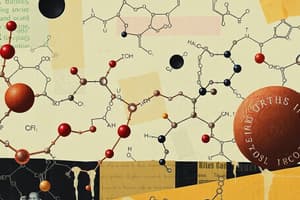Podcast
Questions and Answers
¿Cuál de los siguientes enunciados sobre los aminoácidos es correcto?
¿Cuál de los siguientes enunciados sobre los aminoácidos es correcto?
- Los aminoácidos se sintetizan exclusivamente en el hígado.
- Todos los aminoácidos son esenciales.
- Hay 30 aminoácidos estándar.
- Los aminoácidos se combinan mediante enlaces peptídicos. (correct)
Las proteínas tienen una función exclusivamente estructural.
Las proteínas tienen una función exclusivamente estructural.
False (B)
¿Qué grupo funcional se encuentra en todos los aminoácidos?
¿Qué grupo funcional se encuentra en todos los aminoácidos?
Amino y carboxilo.
El ADN está compuesto por __________, que incluye desoxirribosa.
El ADN está compuesto por __________, que incluye desoxirribosa.
Empareja los tipos de estructuras de las proteínas con su descripción:
Empareja los tipos de estructuras de las proteínas con su descripción:
¿Cuál de las siguientes funciones no está asociada con las proteínas?
¿Cuál de las siguientes funciones no está asociada con las proteínas?
Los aminoácidos no esenciales deben ser obtenidos únicamente de la dieta.
Los aminoácidos no esenciales deben ser obtenidos únicamente de la dieta.
¿Cuántos tipos principales de ácidos nucleicos existen?
¿Cuántos tipos principales de ácidos nucleicos existen?
Flashcards
Aminoácidos
Aminoácidos
Compuestos orgánicos que contienen un grupo amino (-NH2) y un grupo carboxilo (-COOH). Son los bloques de construcción de las proteínas.
Aminoácidos estándar
Aminoácidos estándar
Las 20 unidades básicas que forman las proteínas. Cada aminoácido, con su cadena lateral única (grupo R), le da propiedades especiales a la proteína.
Enlace peptídico
Enlace peptídico
Enlace covalente que une dos aminoácidos para formar cadenas de proteínas. Se forma mediante una reacción de deshidratación.
Proteínas
Proteínas
Signup and view all the flashcards
Estructura primaria de una proteína
Estructura primaria de una proteína
Signup and view all the flashcards
Estructura secundaria de una proteína
Estructura secundaria de una proteína
Signup and view all the flashcards
Estructura terciaria de una proteína
Estructura terciaria de una proteína
Signup and view all the flashcards
Estructura cuaternaria de una proteína
Estructura cuaternaria de una proteína
Signup and view all the flashcards
Study Notes
Amino Acids
- Amino acids are organic compounds containing both an amino group (-NH2) and a carboxyl group (-COOH).
- They are the building blocks of proteins.
- There are 20 standard amino acids, each with a unique side chain (R group).
- The R group determines the specific properties of each amino acid (e.g., polarity, charge).
- Amino acids are linked together by peptide bonds to form polypeptide chains.
- Peptide bonds are formed through a dehydration reaction.
- The sequence of amino acids in a polypeptide chain determines its structure and function.
- Essential amino acids cannot be synthesized by the body and must be obtained from the diet.
- Nonessential amino acids can be synthesized by the body.
- Amino acids are involved in many cellular processes beyond protein synthesis, like energy metabolism.
Proteins
- Proteins are complex molecules composed of one or more polypeptide chains.
- Proteins have diverse functions in living organisms, including:
- Structural support (e.g., collagen).
- Catalysis (e.g., enzymes).
- Transport (e.g., hemoglobin).
- Regulation (e.g., hormones).
- Defense (e.g., antibodies).
- Protein structure is hierarchical:
- Primary structure: linear sequence of amino acids.
- Secondary structure: local folding patterns (e.g., alpha-helices, beta-sheets).
- Tertiary structure: overall 3D shape of the polypeptide chain.
- Quaternary structure: arrangement of multiple polypeptide chains in a complex protein.
- Protein structure is crucial for its function.
- Protein shape can be altered by environmental factors (e.g., temperature, pH).
- Denaturation occurs when a protein loses its 3D structure, and often its function.
- Proteins are crucial for maintaining and regulating most of the cellular processes.
Nucleic Acids
- Nucleic acids are the informational molecules of cells.
- They store and transmit genetic information.
- Two main types of nucleic acids:
- DNA (deoxyribonucleic acid)
- RNA (ribonucleic acid)
- DNA:
- Double-stranded helix.
- Composed of nucleotides:
- Deoxyribose sugar
- Phosphate group
- Nitrogenous base (adenine, thymine, guanine, cytosine).
- Stores genetic information.
- Typically found in the nucleus of eukaryotic cells.
- RNA:
- Single-stranded.
- Composed of nucleotides:
- Ribose sugar
- Phosphate group
- Nitrogenous base (adenine, uracil, guanine, cytosine).
- Several types of RNA have crucial roles in protein synthesis:
- mRNA (messenger RNA)
- tRNA (transfer RNA)
- rRNA (ribosomal RNA)
- Involved in protein synthesis and gene regulation.
- The sequence of nucleotides in DNA determines the sequence of amino acids in proteins.
- DNA replication is the process of copying DNA to produce identical copies.
- Gene expression is the process by which genetic information is used to synthesize proteins.
- Nucleic acids are crucial for all life processes, underpinning heredity and cellular function.
Studying That Suits You
Use AI to generate personalized quizzes and flashcards to suit your learning preferences.




